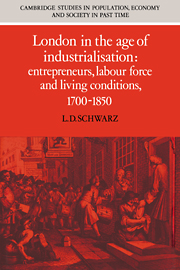Book contents
- Frontmatter
- Contents
- List of figures
- List of tables
- Acknowledgements
- List of abbreviations
- Introduction
- Part I Wealth and occupations in London
- 1 The structure of London's economy and labour force
- 2 Manufacturing, services and the London bourgeoisie
- Part II Fluctuations and mortality in the metropolis
- Part III The standard of living and the London trades
- Conclusion: downstream from industrialisation
- Appendices
- Bibliography
- Index
- Cambridge Studies in Population, Economy and Society in Past Time
2 - Manufacturing, services and the London bourgeoisie
Published online by Cambridge University Press: 11 September 2009
- Frontmatter
- Contents
- List of figures
- List of tables
- Acknowledgements
- List of abbreviations
- Introduction
- Part I Wealth and occupations in London
- 1 The structure of London's economy and labour force
- 2 Manufacturing, services and the London bourgeoisie
- Part II Fluctuations and mortality in the metropolis
- Part III The standard of living and the London trades
- Conclusion: downstream from industrialisation
- Appendices
- Bibliography
- Index
- Cambridge Studies in Population, Economy and Society in Past Time
Summary
Manufacturing and services in London
Despite the stress on the importance of services in the previous chapter, it would be a great mistake to underestimate the role of London as a manufacturing town. With over 370,000 of its inhabitants in 1851 employed in the manufacturing sector, London was the largest manufacturing town in the country and in Europe. This section will not seek to describe all of London's manufactures, or their geography, but will enquire into the nature of manufacturing in London, why it took place there at all, and the effects that the salient characteristics of manufacturing in London had on the nature of London's workforce. Naturally, those who chose to manufacture goods in London needed to adapt themselves to the advantages and drawbacks of operating in the nation's capital. There were three large drawbacks. In the first place, land cost more, so rents were higher than elsewhere. Secondly, labour cost more, and had a disconcerting tendency to organise itself into trade unions. Thirdly, coal cost more than it did on or near coalfields. On the other hand, there were three large advantages. Proximity to the largest and most concentrated market in the country meant both low transport costs for the finished product and a good observation point for consumers' tastes. The labour may have cost more, but there was a great deal of it, and it came in almost any degree of skill required. Thirdly, London was not only the largest consumer centre in the country; it was also the country's largest port, and for many trades involved in international commerce it was useful to be in London.
- Type
- Chapter
- Information
- London in the Age of IndustrialisationEntrepreneurs, Labour Force and Living Conditions, 1700–1850, pp. 31 - 74Publisher: Cambridge University PressPrint publication year: 1992



